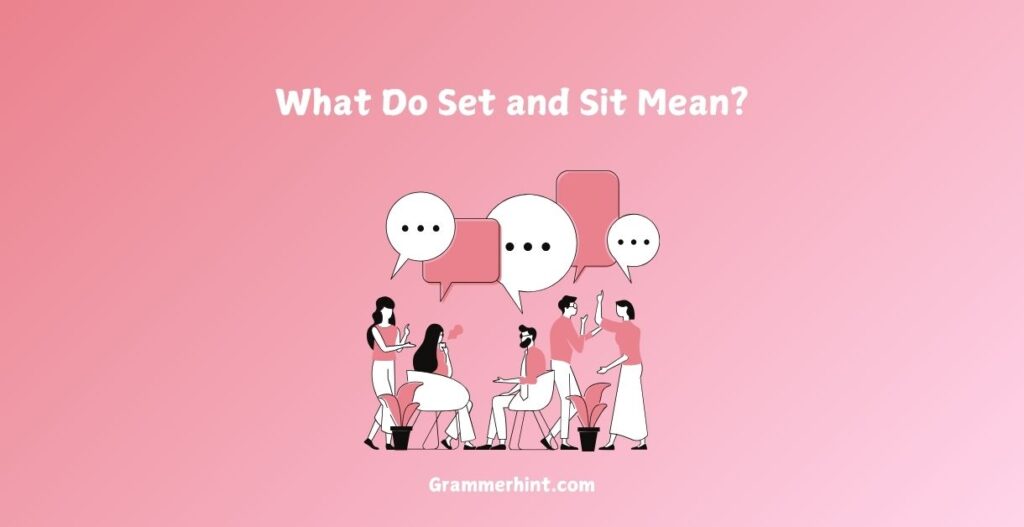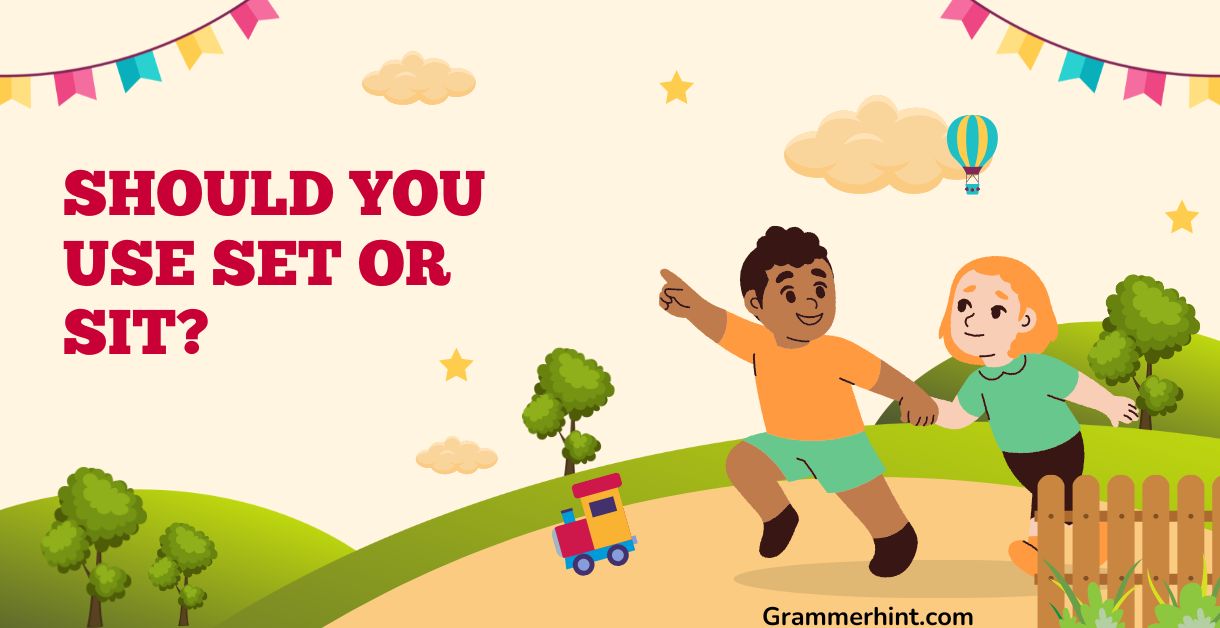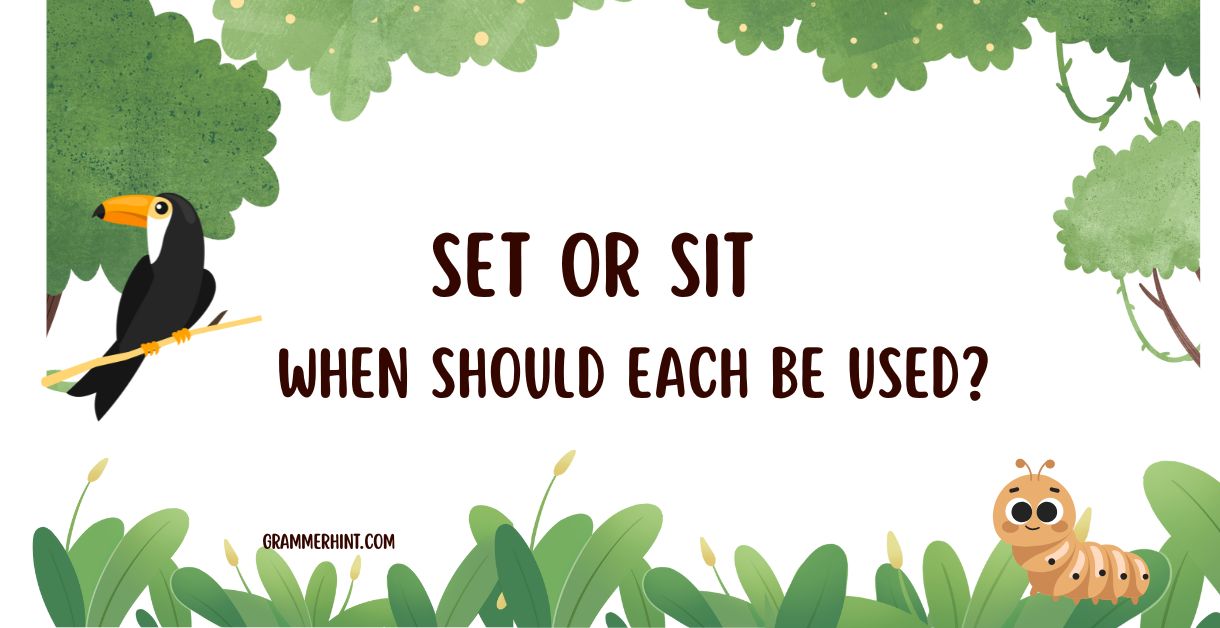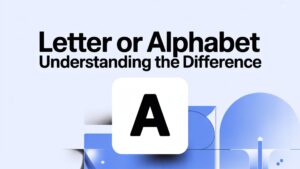Understanding the difference between set and sit can be tricky, especially for language learners and even native English speakers.
These two common verbs look similar, sound similar, and are often confused. However, there are clear distinctions in their meanings, usage, grammar, and verb tenses. In this comprehensive guide, we’ll explore the set vs sit conundrum in depth using real-world examples, grammar explanations, and helpful comparisons.
What Do Set and Sit Mean?

Understanding the core meanings of set and sit will help you choose the right verb in different situations. Here’s where verb usage, syntax context, and descriptive grammar examples come into play.
Set:
Set is a transitive verb, which means it usually needs a direct object. It implies placement and arrangement, or putting something somewhere.
- “Please set the table before dinner.”
- “He set an example by arriving early.”
- “I’ll set the alarm for 6:00 AM.”
These examples show how set involves a subject doing something to an object.
Sit:
Sit is an intransitive verb, meaning it does not require a direct object. It typically refers to a resting position or posture and positioning.
- “Let’s sit on the bench near the lake.”
- “She sat by the fireplace, sipping tea.”
- “He always sits at a desk when working.”
Use sit when talking about someone lowering themselves into a seated position.
Origins of Set and Sit
Understanding the linguistic etymology of these verbs can give you more insight into their current usage.
Set (Etymology)
- Comes from Old English settan, derived from Proto-Germanic satjanan.
- Related to the idea of causing something to sit or stand—hence its link to placement.
Sit (Etymology)
- Originates from Old English sittan, stemming from Proto-Germanic sitjanan.
- Refers to the act of assuming a seated position or being located in a place.
Both words share roots in Proto-Germanic, but evolved into distinct action verbs.
A Simple Tense Table for Set and Sit
This verb tense chart shows how each verb changes with present, past, and future forms.
| Tense | Set | Sit |
|---|---|---|
| Present Simple | set | sit |
| Past Simple | set | sat |
| Present Perfect | has set | has sat |
| Past Continuous | was setting | was sitting |
| Future Perfect Continuous | will have been setting | will have been sitting |
Notice how set doesn’t change in past tense, while sit becomes sat. This is a key tense comparison point.
Should You Use Set or Sit?

When you’re deciding between sit or set, ask yourself a simple question:
Is something being placed or arranged? → Use set
Is someone assuming a seated or resting position? → Use sit
This ties back to the concept of transitive vs intransitive verbs.
Consider:
- “She will set the stage for the performance.”
- “He will sit quietly in the back row.”
It’s all about placement vs posture.
Set vs Sit
Here’s a breakdown of key differences in usage and meaning.
| Feature | Set | Sit |
| Verb Type | Transitive | Intransitive |
| Requires Direct Object? | Yes | No |
| Primary Function | Placement and Arrangement | Resting Position |
| Example | “Set the book on the shelf.” | “Sit on the couch.” |
| Grammar Category | Action-Based | Passive Posture |
| In Grammar | Set in grammar involves direct object. | Sit in grammar is subject-centered. |
Use this table for fast grammar rules reference when writing or speaking.
Examples in Context
Let’s look at real-life usage, including emails and day-to-day conversation.
Set:
Email Example:
Subject: Preparing for the Client Meeting
Hi Megan,
Please set the projector up before 9:00 AM. Also, remember to set the table in the lounge for refreshments.
Thanks,
—Daniel
Other Sentences:
- “We need to set a goal for Q3.”
- “She set up a tent in the backyard.”
- “The teacher set an example by being punctual.”
Sit:
Email Example:
Subject: Office Ergonomics Reminder
Hello Team,
Be sure to sit with proper posture while working at your desks. Good sitting posture reduces strain and boosts focus.
Regards,
—Linda
Other Sentences:
- “He likes to sit on the windowsill and read.”
- “They sat in the audience quietly.”
- “Please sit at a desk, not on the floor.”
A Final Look at Set or Sit
So, when to use set or sit? It all depends on whether you’re positioning an object or describing a person at rest. If you’re unsure, remember:
- Set = Action of placing something (transitive verb)
- Sit = Action of lowering oneself into position (intransitive verb)
These English verb differentiation points help with writing accurately in English. Mastering the difference between set and sit improves your communication clarity.
Understanding verb tenses, direct object requirement, and even etymological roots contributes to better language learning and everyday usage.









